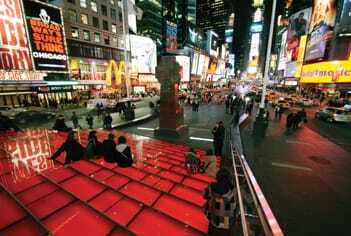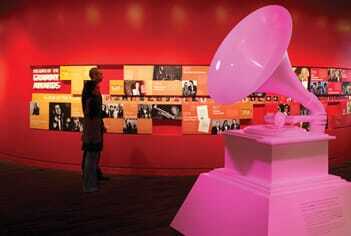Cultural and entertainment districts are not a quick fix, but the slow weaving together of smart, sometimes big, often small, urban solutions.
“American cities are always looking for quick fixes to revive their moribund downtowns,” Witold Rybczynski, professor of urbanism at the University of Pennsylvania, wrote in a May 15 New York Times op-ed article, a review of the High Line, New York City’s popular elevated park. “Sadly, the dismal record of failed urban design strategies is long: downtown shopping malls, pedestrianized streets, underground passages, skyways, monorails, festival marketplaces, downtown stadiums—and that most elusive fix of all: iconic cultural buildings. It appears likely that we will soon be adding elevated parks to the list.”
It is hard to argue with his premise that such projects are beyond the reach of most cities or that successful urban revitalization depends on far more than a single, shining idea. In fact, what is working in communities large and small across the country are cultural and entertainment districts—well-recognized, compact, mixed-use districts in which a high concentration of cultural and/or entertainment venues creates multiple attractions within a defined destination.
According to the Iowa Department of Cultural Affairs, as of December 2009 more than 90 cities in the United States had planned or implemented cultural districts, positioning arts and culture at the center of other revitalization efforts. Iowa is one of many states that have established certification programs for such districts, providing benefits that could include tax credits for the rehabilitation of historic structures, incentives for live/work space, and access to financial assistance programs from state agencies.
| The iconic red stairs in New York City’s Times Square. |
Although the movement by states and communities to recognize and nurture fledgling districts is relatively recent, cultural and entertainment quarters have been a part of urban centers for centuries. Sometimes they develop organically, spurred by local artists and neighbors; sometimes they are promoted and funded by civic and government leaders; and other times private development takes the lead. Today, most thriving districts are the beneficiaries of a mix of public and private interests and financing.
For a number of reasons, districts of all scales and in a variety of models succeed—enticing locals and tourists alike to extend their visits and return—where singular “grand projects” fail. First, a collection of destinations allows visitors to create multiple, individual itineraries through the districts. Also, there are often relationships among the cultural and entertainment assets within the district ecology that create an “experience dialogue” that encourages further exploration. In addition, both the physical and the experiential components of the district can be continually added to or refreshed to improve the sense of place and the quality of the visitor interaction. Finally, each separate asset can be branded to create a set of nested brands within the urban brand of the district, which becomes part of the city’s overarching brand message.
“Districts are where it is happening, especially as tourism becomes as important as goods and services to urban economies,” says Michael S. Rubin, head of Baltimore-based MRA International and one of the leading thinkers in the urban entertainment field. “Offering visitors choices about where to go and what to see allows people to create their own personal itineraries. This sense of possibility helps to bridge the gap between generations and cultures, even when the choices are embedded in well-planned and programmed entertainment districts.”
“The best districts build on a classic formula—small blocks, pedestrian scale, active uses at the corners, business that spills out on the sidewalks, and outdoor gathering spaces,” says Nate Cherry, vice president/director of planning and urban design in the Los Angeles office of RTKL. “At L.A. Live, we didn’t have the benefit of an existing urban context. Instead we had the Staples Center arena and the convention center, so it was important that the design provide the scale, the pathways, and plazas to encourage people coming for a game or a concert to stay and explore the restaurants and shops or to make plans to come back.” As a result, L.A. Live responds not only to the needs of conventioneers and sports fans, but also to those of tourists and residents from around the region, building on the sports and music identity of Staples Center to create a true mixed-use district.
Still, it does not take a multibillion-dollar development to generate excitement and economic activity. Ray Gastil, who heads Seattle-based Gastilworks Planning & Design, observes a similar scenario on a much more modest scale in the Pike/Pine district in Seattle. “While cultural districts are never purely organic, Pike/Pine developed around the music clubs that arrived with grunge musicians in the 1990s,” he says. “Today, music remains both a precious commodity and a local industry, and the city has worked with neighborhood residents, businesses, and developers to help keep the character of the district as it grows.” Or, as the Seattle Times noted this January 23, “It’s hard to deny the frisson of a neighborhood having its ‘moment’ when you walk up East Pike Street between Broadway and 12th Avenue and take in its mix of fine restaurants, rowdy taverns, heaving nightclubs, chatty cafés, and steamy sidewalk food carts, all under the gaze of loft apartments.”
The same dynamic that leads visitors from the Grammy Museum to a concert at the Nokia Theater at L.A. Live or from club to club in Pike/Pine takes on another dimension in a long-established cultural district—the center of Philadelphia, where a rich collection of historic assets engage the visitor in a narrative that moves them not only through the district but through history. More than 2 million heritage tourists a year visit Philadelphia, following itineraries that take them from Independence Hall to the Liberty Bell and on to dozens of other historic treasures.
One of the newest destinations in the district is the National Museum of American Jewish History, where the themes and design of the exhibits take full advantage of its location. “Visitors begin their journey through the museum looking out at Independence Mall and travel through the exhibits organized around the concept of freedom as seen through the lens of the Jewish experience in America,” explains Cybelle Jones, creative director at Gallagher & Associates, museum planners and exhibit designers based in Silver Spring, Maryland. “The museum and the exhibits are in a dialogue with their historic neighbors, and that encourages visitors to enrich their experience with further stops at nearby institutions.”
The opportunities for heritage tourists continue to expand as the U.S. National Park Service and other organizations develop new museums and exhibits focused on U.S. history, all within blocks of one another. These include the National Constitution Center, the President’s House, and, soon, the American Revolution Center. Yet as important as such specific destinations are in the success of districts, the public realm plays an equally important role.
In New York City, recent changes to Broadway in the blocks that form one of America’s best-known entertainment districts underscore the power of public spaces to shape perception and increase visitation. The redesign of the plaza at Father Duffy Square and the introduction of the iconic red steps have transformed Times Square, creating a great public space with what have been called “the best seats in the house to watch the greatest show on earth.”
| The Grammy Museum, occupying four floors of exhibit space at the heart of L.A. Live in Los Angeles. |
“The Times Square steps are not only visually dramatic; their arrival prefigured a more dramatic change—the conversion of Broadway to permanent pedestrian use,” says William B. Fellows, a principal at PKSB in New York City and designer of the plaza. “Times Square, at the heart of the theater district, has assumed a new public function and identity.”
Like many other districts, Times Square is home to a number of conflicting uses that contribute to the vibrancy of the environment. The Broadway/Times Square brand captures the important assets of the district—theaters, restaurants, dizzying signs, and now the public gathering space. In turn, New York City lays claim to “the bright lights of Broadway” as part of its identity as a cultural capital and world city.
Likewise, in a city synonymous with entertainment, the L.A. Live brand creates value for Los Angeles as a physical center for music and sports at the same time that it supports the city brand by showcasing other powerful identities, including the sports teams associated with Staples Center and the Grammys—both the National Academy of Recording Arts and Sciences awards show and now the museum.
Bob Santelli, executive director at the Grammy Museum, understands the strong interplay of identity between cultural institutions and their environments, having served at Cleveland’s Rock and Roll Hall of Fame and at the Experience Music Project in Seattle before coming to Los Angeles. “AEG, the developers, felt a need to balance the entertainment and attractions, and the Grammy Museum was a perfect fit with their concept of L.A. Live as the music capital of L.A. and having the awards presented at the Staples Center annually,” he says. “And while we are certainly part of the entertainment district here, we also have a broader mission as a cultural institution in the city. We have an education program that provides local schools with music resources, which really makes us part of the larger community.”
Santelli’s description of L.A. Live’s approach, seen from the perspective of a single destination, demonstrates the strengths of the cultural and entertainment district strategies. The museum is a destination within a destination; its content resonates with the other district components and its brand with that of the district and the city itself. Districts are not a quick fix but the slow weaving together of smart, sometimes big, often small, urban solutions.






